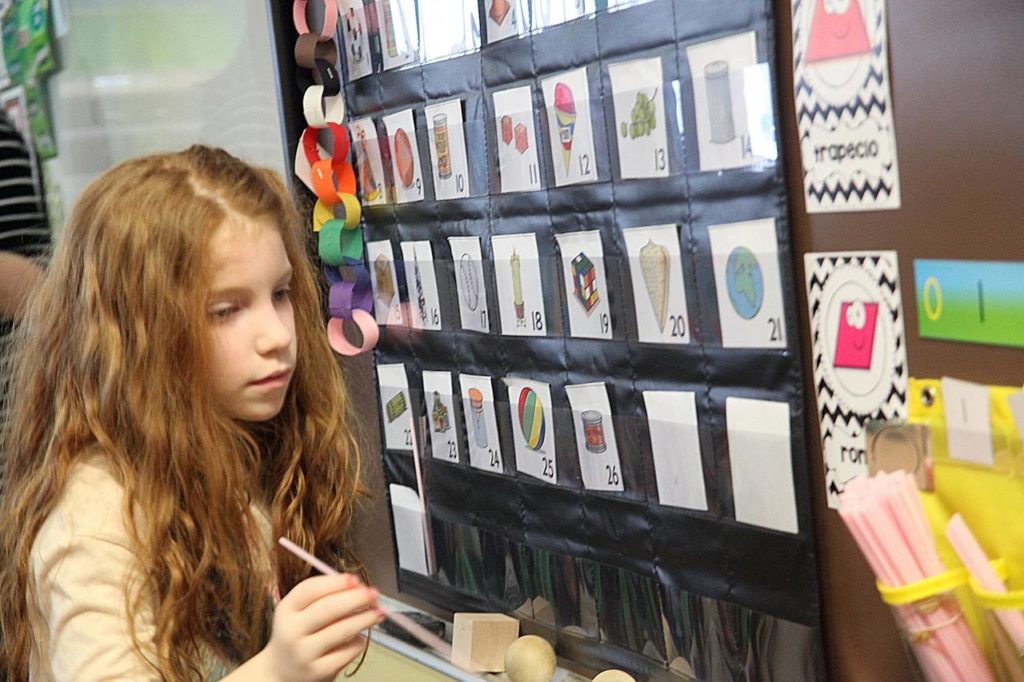Dual-Language Classes for Kids Grow in Popularity
In increasingly global economy, more parents seek leg up for their children through early immersion programs

Kindergartener Leah Grunwell counts items in Spanish on a calendar at Parkview Elementary school in Valparaiso, Ind., which has been awarded a grant for dual-language immersion classes. Photo: Tony V. Martin/The Times of Northwest Indiana/Associated Press
Penelope Spain is desperate to make her 3-year-old son fluent in a second language.
Last year, the Washington, D.C., attorney competed with hundreds of other parents for a spot at several prekindergarten programs that teach lessons partly or mostly in Spanish. She struck out. “I sat on the couch and just cried endlessly,” she recalled. Now she has widened her search to French and Mandarin schools.
Public schools that immerse students in a second language have become hot destinations for parents seeking a leg up for their children in a global economy. New York, Utah, Delaware and other states are adding classrooms where at least half of lessons are taught in a second tongue.
Many of these programs started as a way to ease students from immigrant households into U.S. classrooms. Instead, they are attracting droves of native English-speaking families who bet that top jobs will increasingly demand bilingual skills thanks to foreign trade and a growing Latino population in the U.S. Programs that immerse students in Spanish, Mandarin and Arabic are seeing heavy interest starting in preschool.
“If you have another language, it opens up so many more opportunities for your career,” said Ms. Spain, who is non-Hispanic white.
Delaware’s governor is pouring $1.9 million a year into more than tripling the number of students in dual-language school programs for Spanish and Mandarin, with the goal of having 10,000 students in these classrooms by 2022. Utah’s 138 language immersion programs have seen such high demand that the state surpassed its target of enrolling 30,000 students a year ahead of schedule in 2014.
“In most parts of the county, it’s something parents are demanding,” says Marty Abbott, executive director of the American Council on the Teaching of Foreign Languages. She calls people like Ms. Spain “language moms.”
Some programs have sparked a backlash. When Houston’s public school district opened an Arabic dual-language school in August, about 30 protesters camped outside, waving American flags and anti-Muslim signs. “There’s some level of fear about it,” said Kate Adams, principal of the Arabic Immersion Magnet School in Houston.
The school district started the program in part because Houston’s energy industry attracts a sizable number of Middle Eastern workers. Yet in its inaugural class this fall, only about 10% of students came from households that spoke Arabic, Ms. Adams said. Many of the rest—a mix of white, black and Latino pupils—have parents who see broad educational benefits in learning a second language early in life. About three students applied for each open spot at the school, where half of all lessons are taught in Arabic.
Parents are being attracted by research suggesting that students gain mental flexibility when they learn a language early in life instead of waiting until high school. In a multiyear study starting in 2007, George Mason University emeritus professors Wayne Thomas and Virginia Collier looked at native and nonnative English-speaking students mixed together in classrooms where teachers taught in both English and a second language. They found that all students scored higher in reading and math than students in non dual-language classrooms, regardless of their ethnicity or socioeconomic status.
“The way the kids think and analyze is more robust than a monolingual school,” said Melody Meade, primary school principal at the Washington International School, a private D.C. immersion school.
In the District of Columbia, dual-language programs have helped turn some once-struggling public schools into attractive destinations. Tyler Elementary School, located just over a mile east of the U.S. Capitol Building, was placed on the district’s list of its 40 worst-performing schools four years ago.
But its Spanish dual-language program, coupled with a desirable location and overall improvements in district public schools, has created such heavy demand that more than 300 students are on a wait list for spots there this school year.

Spanish instructor Kristin Nguyen teaches a class at Parkview Elementary School. Dual-language classes are attracting native English-speaking families who bet that top jobs will increasingly demand bilingual skills thanks to foreign trade and a growing Latino population in the U.S. Photo: Tony V. Martin/The Times of Northwest Indiana/Associated Press
On a recent afternoon at Tyler, not a word of English was spoken as kindergarten teacher Laura Chapa walked students through a math lesson, counting from one to 11 as she pulled colored chips out of a bag. A sign labeled the class library as a “biblioteca,” including sections for books about “familia” and “animales.”
Tyler’s mostly black student body has diversified to include more white, Latino and Asian students drawn to the dual-language program. “It’s been a win-win for the school,” says Principal Mitchell Brunson. The district’s public school system plans to add three new dual-language programs this coming school year, and D.C. parents have formed an advocacy group to push for more.
“They’re not schools that middle-class people would be attracted to if you just looked at test scores and demographics and condition of the building,” said E.V. Downey, a Washington educational consultant. “They would generally speaking be a no-go, and yet they’re of great interest because of the immersion programs.”

 Previous Post
Previous Post Next Post
Next Post




